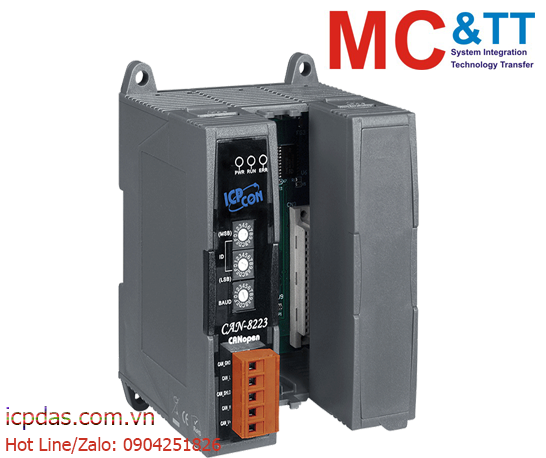Module CANopen Remote 2 cổng I/O Expansion ICP DAS CAN-8223-G
CANopen, a kind of communication protocols, is based on the intelligent field bus(CAN bus). It was developed as a standardized embedded network with highly flexible configuration capabilities. It provides standardized communication objects for real-time data(Process Data Objects, PDO), configuration data(Service Data Objects, SDO), network management data(NMT message, and Error Control), and special functions(Time Stamp, Sync message, and Emergency message). Nowadays, CANopen is used in many various application fields, such as medical equipment, off-road vehicles, maritime electronics, public transportation, building automation and etc.
CAN-8223 main control unit is specially designed for the slave devices of CANopen protocol. It follows the CANopen Spec DS-301 V4.02 and DSP-401 V2.1, and supplies and supplies many features for users, such as dynamic PDO, EMCY object, error output value, SYNC cyclic and acyclic, …and etc.
In order to expand I/O channel more flexible, an CAN-8223 supports 2 slots for I/O expansion and suits with a lot of ICPDAS DI/AI/DO/AO slot modules. Users can choice DI/DO/AI/AO modules of I-87K series or I-8000 series to fit the customized practice applications. In addition, we also provide utility tool to allow users to create the EDS file dynamically. The EDS file is based on CANopen SP306 and can be compatible with different CANopen master interfaces. The application architecture is as image on the left.


• Industrial Machinery
• Laboratory Equipment & Research
• Restaurant Appliances
• Maritime
• Medical
• Specialty Vehicles…etc.
CANopen, a kind of communication protocols, is based on the intelligent field bus(CAN bus). It was developed as a standardized embedded network with highly flexible configuration capabilities. It provides standardized communication objects for real-time data(Process Data Objects, PDO), configuration data(Service Data Objects, SDO), network management data(NMT message, and Error Control), and special functions(Time Stamp, Sync message, and Emergency message). Nowadays, CANopen is used in many various application fields, such as medical equipment, off-road vehicles, maritime electronics, public transportation, building automation and etc.
CAN-8123 / CAN-8223 main control unit is specially designed for the slave devices of CANopen protocol. It follows the CANopen Spec DS-301 V4.02 and DSP-401 V2.1, and supplies and supplies many features for users, such as dynamic PDO, EMCY object, error output value, SYNC cyclic and acyclic, …and etc.
In order to expand I/O channel more flexible, an CAN-8×23 supports 1/2 slot(s) for I/O expansion and suits with a lot of ICPDAS DI/AI/DO/AO slot modules. Users can choice DI/DO/AI/AO modules of I-87K series or I-8000 series to fit the customized practice applications. In addition, we also provide utility tool to allow users to create the EDS file dynamically. The EDS file is based on CANopen SP306 and can be compatible with different CANopen master interfaces. The application architecture is as image on the left.
| NMT |
Slave |
| Error Control |
Node Guarding and Heartbeat Producer protocol |
| No. of PDOs |
16Rx , 16Tx |
| PDO Modes |
Event Triggered, Remotely requested, Cyclic and acyclic SYNC |
| PDO Mapping |
Available |
| No. of SDOs |
1 server, 0 client |
| Emergency Message |
yes |
| CANopen Version |
DS-301 v4.02 |
| Device Profile |
DSP-401 v2.1 |
| Baud Rate Setting by Rotary Switch |
10K, 20K, 50K, 125K, 250K, 500K, 800K, and 1Mbps |
| Produce EDS file Dynamically |
yes |
| CAN, ERR, and Tx/Rx LED |
yes |
CAN-8×23 can automatically scan the I-8K/I-87K modules plugged in the main unit and assigned these modules to the specific application. Before users apply the CAN-8×23 in CANopen applications, they must understand the relationship between these CANopen application and device object dictionary in CAN-8×23. Therefore, we provide the CAN-8×23 Utility Tool (CAN slave utility, CAN_SL.exe) to allow users to view the important information, such as slot module information, Rx and Tx PDO mapping, and device object dictionary. After finishing the utility configuration, it will create the EDS file for users’ CAN-8×23 device. Furthermore, if the CAN-8×23 EDS file is not needed for users’ application, users only need to set the Node ID and baud by hardware rotary switch. Then, after connecting the wire and turning on the CAN-8×23, it can work normally on the CAN bus network through CANopen protocol.
The following simple steps show how to use CAN-8×23 in CANopen protocol.





